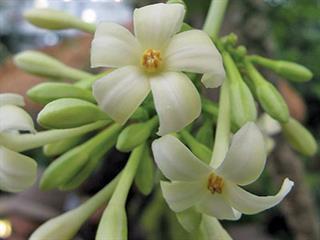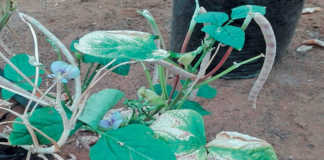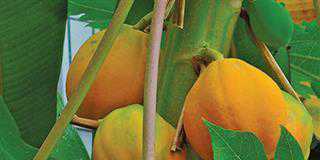
The papaya trees in an orchard must be spaced so that they do not interfere with each other’s growth or block light needed for photosynthesis. To use sunlight optimally, orchard rows should orientate north/south. Where this orientation is not possible, allow a wider spacing to improve light penetration and air movement.
The right way to plant papayas
Young papaya plants are ready to be planted out in the open when they are about 200mm, measured from the base of the plant to the growing tip. At each planting position, dig a hole approximately 200mm x 200mm x 200mm (about one spadeful of soil).
Just before planting, fill the holes with water to cool the soil and promote contact between roots and the soil. Cut a slit down one side of the plastic bag to make it easier to remove the bag, and place the plant upright in the hole. Take care to do this properly; if planted at an angle, the tree will continue growing like this for the rest of its life.
The base of the stem of the adult tree will then lie on the ground and the upper two-thirds of the stem will form a flattened C-shape, with the growth tip pointing straight upwards. As the tree ages, the increased weight will cause more of the stem to lie on the ground, making it difficult for workers to move between rows during weed control and harvesting. When planting, do not loosen the roots as this will cause the plant to lodge. If there is more than one plant in a bag, do not separate them.
Soil and growth medium
Rake in the soil from around the hole towards the stem to lightly cover the roots and growth medium, but do not pile too much soil around the stem. You should be able to see the original growth medium that was in the bag. In other words, the surface of the growth medium should be level with the soil surface.
Apply approximately 40g LAN immediately after planting around the base of each plant. Water thoroughly and frequently in the weeks following planting, especially in midsummer. If evaporation is excessive, mulching is recommended. Use any mulch.
Thinning and removing suckers
Thin out the plants as soon as the sex of trees can be determined at about six to nine months after planting. Remove all suckers on the stem below the fruit and between the fruit as they could damage the maturing fruit. Suckers near the top of the tree are sometimes kept if the growth tip dies.
Short economic lifespan
Three years is usually the maximum lifespan of a planting. Generally, after the second harvesting season, the plants become too tall for easy harvesting. Thus, a papaya planting is usually replaced every two to three years.
Source: Directorate Agricultural Information Services, DAFF, in co-operation with the ARC-Institute for Tropical and Subtropical Crops. Please note that the foregoing is intended merely as an overview of papaya production.













